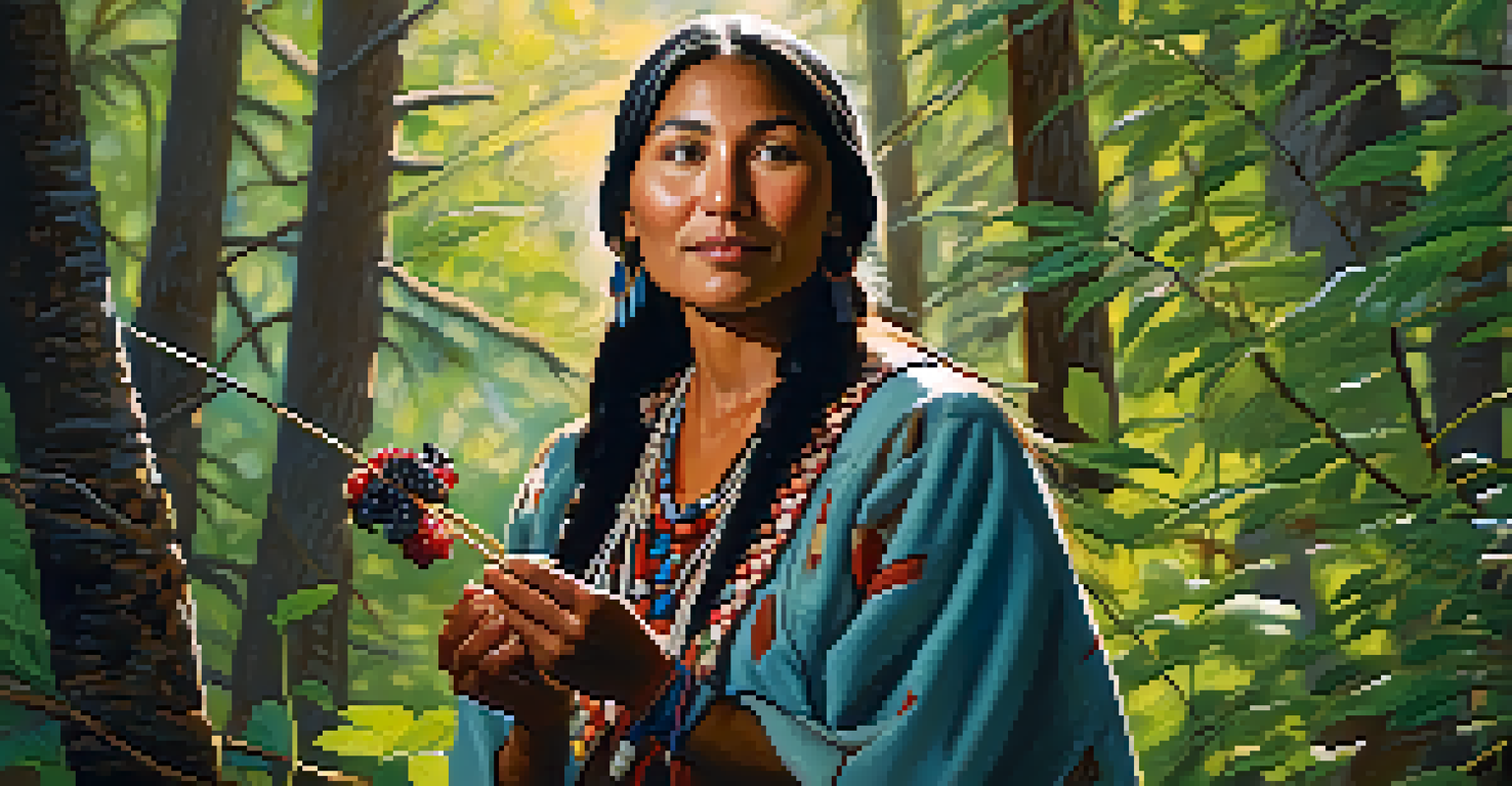The Influence of Raw Food Diets on Native American Cultures

Understanding the Basics of Raw Food Diets
Raw food diets primarily consist of unprocessed, uncooked foods, often focusing on fruits, vegetables, nuts, and seeds. This approach values the natural state of food, aiming to preserve its nutrients and enzymes, which can be lost during cooking. For many, adopting a raw food diet is about health, vitality, and a connection to nature.
Let food be thy medicine and medicine be thy food.
In Native American cultures, the relationship with food often goes beyond mere sustenance; it is deeply intertwined with identity, spirituality, and community. Many Indigenous peoples have historically practiced a form of raw food diet through their traditional foraging and hunting methods, emphasizing the value of fresh, local ingredients. This profound respect for nature mirrors the principles of modern raw food diets.
The fundamental idea of consuming food in its natural state has historical roots in Native American practices. This shared philosophy between raw diets and Indigenous foodways illustrates a connection to the land and an awareness of seasonal cycles, promoting a sustainable lifestyle that honors both health and tradition.
Historical Context of Native American Diets
Before the arrival of Europeans, Native American diets varied significantly across regions, often featuring raw and minimally processed foods. Tribes relied heavily on local flora and fauna, consuming numerous fruits, vegetables, nuts, and fish that were often eaten raw or dried for preservation. This traditional diet was not only nutritious but also reflective of a deep understanding of the environment.

Different tribes had unique dietary practices shaped by their geographic locations. For example, coastal tribes enjoyed fresh fish and seaweed, while those in the plains relied more on game and wild plants. This diversity illustrates the adaptability of Native American cultures in utilizing their natural surroundings for nourishment, much like the principles of modern raw food diets.
Raw Diets Embrace Nature's Gifts
Raw food diets prioritize unprocessed, uncooked foods, reflecting a deep connection to nature and preserving essential nutrients.
Many of these traditional practices have persisted despite the profound changes brought by colonization. Today, there’s a resurgence of interest in these diets, as Native communities are reconnecting with their ancestral foodways, emphasizing the importance of raw and whole foods in promoting health and cultural identity.
The Spiritual Connection to Food
For many Native Americans, food is not merely fuel; it is a sacred element of their culture and spirituality. The act of gathering, preparing, and sharing food is often accompanied by rituals and traditions that honor the earth and its gifts. This holistic approach to food resonates with the principles of raw food diets, where the focus is on purity and naturalness.
We are what we eat. Our food becomes our body and mind.
Incorporating raw foods into their diets can enhance the spiritual connection to food, as many Indigenous peoples believe that natural foods carry the essence of the earth. This perspective encourages mindfulness in eating, fostering gratitude and respect for nature. By consuming raw foods, individuals may find a deeper appreciation for the cycles of life and the interconnectedness of all beings.
This spiritual connection to food has led to the revitalization of traditional practices, where raw foods play a vital role. By embracing these elements, Native American communities are not only preserving their heritage but also promoting holistic well-being through a diet that nourishes both body and spirit.
Modern Influences on Native American Diets
As modern diets have evolved, many Native American communities have faced challenges with processed foods and health issues. However, there has been a growing movement to return to traditional food practices, including raw diets. This resurgence is fueled by a desire for better health and a reconnection to cultural roots.
Organizations and initiatives are actively working to educate Indigenous communities about the benefits of traditional and raw foods. These programs often involve workshops, community gardens, and cooking classes that emphasize the preparation of local, seasonal ingredients. This shift not only fosters healthier eating habits but also revitalizes cultural practices surrounding food.
Cultural Resurgence in Food Practices
Many Native American communities are revitalizing traditional diets, including raw foods, to reconnect with their heritage and improve health.
The blending of traditional knowledge with modern nutrition science is creating a unique culinary landscape. Many Native American chefs and nutritionists are incorporating raw food principles into contemporary dishes, bridging the gap between tradition and innovation, and showcasing the richness of their culinary heritage.
Nutritional Benefits of Raw Foods
Raw foods are packed with vitamins, minerals, and enzymes that can be diminished through cooking. For Native Americans looking to improve their health, incorporating more raw fruits, vegetables, and nuts can provide a wealth of nutrients. This dietary approach can support better digestion, increased energy levels, and overall wellness.
Moreover, many traditional Native American foods are inherently raw or can be easily adapted to a raw format. For instance, wild berries, nuts, and leafy greens are often consumed fresh, aligning with the principles of a raw food diet. By embracing these foods, communities can enjoy both nutritional benefits and cultural significance.
The emphasis on whole, unprocessed foods also fosters a greater awareness of food sources and environmental sustainability. As Native Americans embrace raw food diets, they not only improve their health but also promote practices that protect their land and resources for future generations.
Challenges Faced by Native American Communities
Despite the benefits of raw food diets, many Native American communities face significant challenges in accessing fresh and healthy foods. Factors such as food deserts, economic constraints, and historical injustices have made it difficult for these communities to maintain traditional diets. The reliance on processed foods has led to increased health disparities among Indigenous populations.
Additionally, there can be a cultural disconnect when it comes to modern dietary practices. While some individuals embrace raw foods, others may find it challenging to shift away from traditional cooking methods that have been passed down through generations. Bridging this gap requires sensitivity and understanding of the cultural significance of food preparation.
Challenges in Food Accessibility
Despite the benefits, Native American communities face obstacles such as food deserts and economic constraints in accessing fresh, healthy foods.
Efforts are underway to address these challenges, with initiatives aimed at improving food access and education. By promoting the benefits of raw foods and supporting local agriculture, communities can work towards building a healthier future while honoring their rich culinary heritage.
The Future of Raw Food Diets in Native American Cultures
The future of raw food diets within Native American cultures looks promising as more individuals seek to reconnect with their culinary roots. The integration of traditional knowledge with modern dietary practices is fostering a renewed interest in healthy eating habits. This revival not only promotes physical health but also strengthens cultural identity and community bonds.
As young generations become increasingly aware of the health benefits associated with raw foods, we can expect to see more innovative culinary creations that honor Indigenous traditions. Chefs are experimenting with raw ingredients to create dishes that reflect both cultural heritage and contemporary tastes, making traditional foods accessible to a broader audience.

Ultimately, the resurgence of raw food diets among Native Americans represents a powerful movement towards healing and reclaiming identity. By embracing their ancestral foodways, these communities are not only nurturing their bodies but also preserving their rich history for future generations.